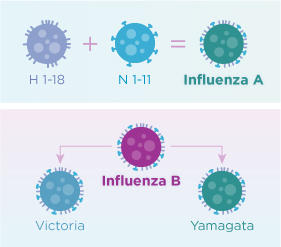
- Flu Facts
How Many Types of Flu Viruses Exist?

While there are technically 4 types of flu, there are also different subtypes.
To start, let’s go over the four different types of flu viruses – A, B, C, and D:
- Influenza A: Influenza A viruses can be found in many different animals, including birds and mammals, as well as humans. These viruses are characterized by surface proteins, including hemagglutinin (“H”) and neuraminidase (“N”). These viruses are further separated into subtypes by number. There are 18 different H subtypes and 11 different N subtypes, and 131 subtype combinations have been detected in nature. Examples of flu viruses in this category include H1N1 and H3N2.
- Influenza B: These viruses only affect people and are characterized according to where the virus was originally isolated. The two main categories (lineages) of influenza B include B/Yamagata and B/Victoria.
- Influenza C: This type of flu can affect people, but most often only causes mild illness. Influenza C infections are not thought to cause human flu epidemics.
- Influenza D: This type of flu primarily affects cattle and is not known to affect people.
To get more complicated, there are also subtypes among the 2 flu viruses (A and B) that affect humans. These subtypes are also sometimes called “strains” of flu. See below for this helpful graphic from the CDC:

So, to answer the original question of how many types of flu viruses exist, the answer is many. Influenza is an illness that can be caused by different combinations of flu viruses.
Sources:
https://www.cdc.gov/flu/about/viruses/types.htm


